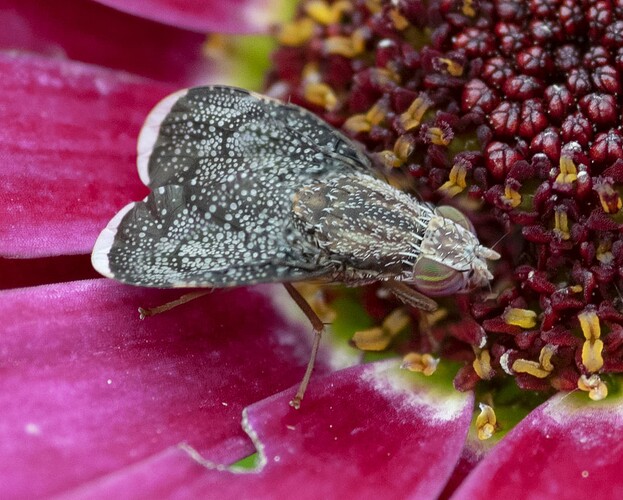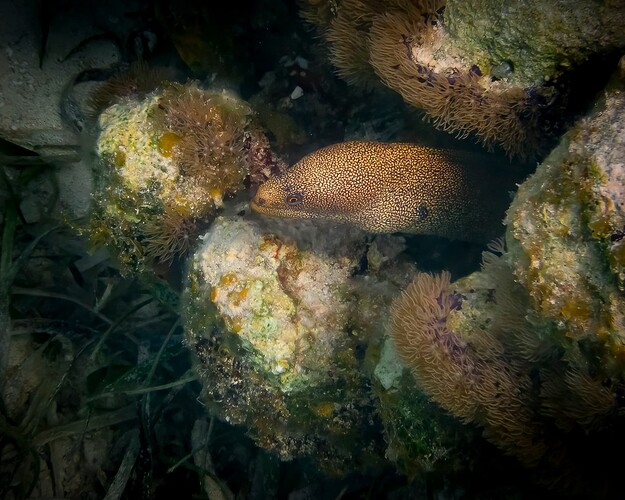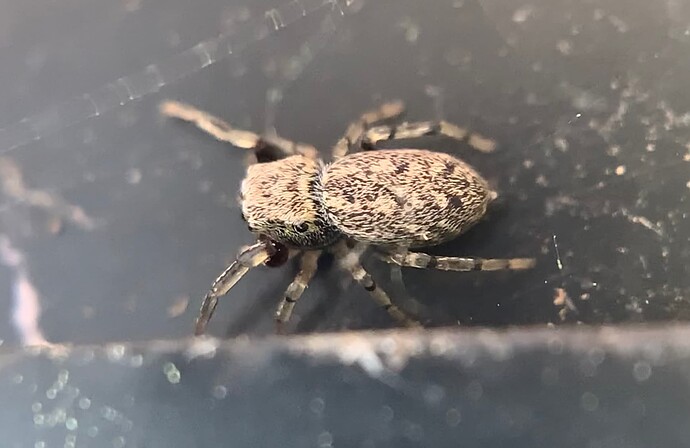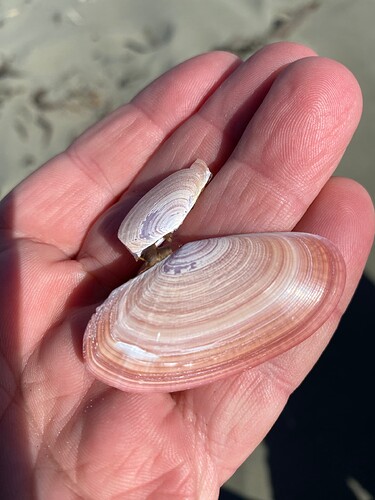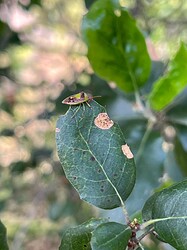That’s a rare buttefly which is in red lists of probably most countries it lives in, it can be locally abundant, but overall it’s not.
What?! Amazing! I saw it had many observations on iNat so I thought it was common.
Today (April 9th 2022) here on Nevis, West Indies, I managed to observe another nice new butterfly species, the Angerona Hairstreak, Electrostrymon angerona
Captured photos of this stunning little fruit fly ( Tephritidae, not Drosophila) a few days ago. I had never seen one like this, and didn’t even know the family existed until finding this one – I thought it was a moth or other small lep from a distance, but quickly noticed the classic “fly face” upon getting closer. A really beautiful specimen.
What a ridiculous idea! The people commenting here are just mainly of the rare sort that do. I for one am lucky to find a lifer more than once every few months, and then only if I’m trying harder than usual. Casual observing doesn’t tend to get beyond the common species (depending on the taxon of interest, of course).
This Noctuidae moth (and lifer) found a spot above one of my neighbor’s garage doors Agrotis vetusta (Old Man Dart) from Alburquerque, NM, US on April 10, 2022 at 11:57 AM by Elliott Gordon
I’m visiting Turks and Caicos right now so I’ve gotten like 100 lifers in the last few days, but the highlight would have to be this Goldentail Moray (Gymnothorax miliaris) that I saw while snorkeling:
New Crabronidae wasp in my life and garden https://www.inaturalist.org/observations/111857545 Nature is fun!
I feel it’s not a good day out for me unless I find a new species.
Which is maybe a sign of addiction!
… but, regardless… I don’t think one new species a week is ridiculous tbh.
As you say… if one limits oneself to a single taxon then that will hinder things… but providing you observe all forms of life, it’s no big deal. Insect populations are so diverse depending on habitat… and changeable each month due to lifespan,etc. A few hours observing per week should be enough to find a new species for most people.
I haven’t got a single lifer for months and it’s not that I don’t try. Without microscoping soil I see no way to find so many lifers. Region I have to live now has observations of 8 890 species, I lack 4 054 of them and those are not so common to find them each day or even each week, many need different conditions, rare or even found in one spot only. Of course living in tropics or even just Western Europe that hardly get any snow and have e.g. frogs mating in February when we get them in the end of April, it’d be much easier, cause insects are likely to not disappear for long and there’re just more of them and more iders.
Good point… the problem is, if insects aren’t your area of expertise it’s up to others to identify your observations, which can take a very long time if you want a species ID. I figure you have to know what something is for it to count as a lifer.
I haven’t got a single lifer for months and it’s not that I don’t try.
Yeah, my qualifier of “most” people was people who haven´t already observed over 4000 species perhaps ! ![]() Nevertheless… for me I am at ∼2000 in UK and still rarely struggle to find something new. And almost all obs are at two inland locations of 1 sq km each (+ the odd coastal trip)…so still plenty to explore. Who knows…I may reach saturation before long though… I can certainly imagine by the time I reach 4000 it will be a different story.
Nevertheless… for me I am at ∼2000 in UK and still rarely struggle to find something new. And almost all obs are at two inland locations of 1 sq km each (+ the odd coastal trip)…so still plenty to explore. Who knows…I may reach saturation before long though… I can certainly imagine by the time I reach 4000 it will be a different story.
I should also note UK taxa is particularly well-mapped in comparison with many other countries. Expertise and resources for identification are not hard to come by for most taxa.
if insects aren’t your area of expertise it’s up to others to identify your observations, which can take a very long time if you want a species ID. I figure you have to know what something is for it to count as a lifer.
Yeah, I guess there are other qualifiers to my statement here then also.
If iNat counts it due to it being a new leaf then I see it as a new species for me… even if indeterminable beyond genus/subfamily. I might also count it as a new species based on a new autosuggest even if it was yet to be verified. So, perhaps I´m not as strict as I could be in my perception of finding a new species.
Nevertheless, spending a good portion of the day observing yesterday at a new location, I found ∼10 new species. One other major caveat in this instance : … I am only at ∼300 species here in Iceland, so lots left to find! However, terrestrial biodiversity here (and at this time of year) is extremely limited compared to most places, so that factor cancels the other out to some degree.
I don’t know if it counts as a lifer but I found a female of a species that I had only previously found males of. A sexually dimorphic species. So kinda like a lifer to me.
Zygoballus rufipes female! (Family Salticidae)
A true lifer that I found this week though was Pelegrina galathea. The only lifer from last week.
Yeah, my qualifier of “most” people was people who haven´t already observed over 4000 species perhaps !
I have 342 observations of 275 species and I have only posted to this thread maybe two or three times. I have a lot of other things going on in my life that prevent me from doing as much observing as I would like. Living in a suburban area means that it takes a bit more thought to find something besides the common suburban species, and honestly, when I do get to go out in nature, I often get so wrapped up in learning more about the species I see regularly and know, looking specifically for lifers goes by the wayside.
Definitely. Going deeper into species one knows is always nice (and probably healthier in many ways). Many folks have a similar profile to you I notice as well - where number of obs = number of species. So we likely just enjoy different aspects of recording / observing nature. Each to their own. ![]()
I don’t believe suburban environments are a qualifier here though. Certainly harder in some ways …but as well as the truly urban fauna which enjoys the extremities of a man-made environment there are always parks, green spots or abandoned areas.
Almost all my records are from within town/city boundaries.
The densest urban area I’ve experienced is Manhattan…but in Central Park alone there are 3500 species listed.
I was very pleased to find this pink sunset clam yesterday. My 20th bivalve species in New Zealand!
I have a Canon see, and a Chromebook which I use for iNat. My Chromebook has no memory card reader, so I’m backed up three weeks. I finally started uploading the weeks-worth of photos today. A few firsts (that I’ve uploaded) included a House Finch, a dead White Sucker, and a dead Vole of some sort.
I’m also really excited to upload what I assume to be a Painted Turtle!
Lifers are hard for me at home nowadays, but just went to visit a new place and immediately saw about 30 new plants on a short walk on the first day. (Went with other non-naturalist people, so constantly had to catch up each time I took a picture of something - could have found a lot more even otherwise).
My favorite still is one I found at home before I left - a Draba cuneifolia which most people would say is a boring weed. I spent about 3 hours searching for it on a dry hillside - I didn’t know it grows there but it was one of two places within about 20 miles where i expected one. Ohio is quite at the edge of its range so it’s actually rare there. Couldn’t find it though with its small size and all the non-native Draba species growing there and finally gave up - then I saw a violet in the distance and went to check it out, and there was 3 beautiful D. cuneifolia plants in full bloom next to it ![]()
This discoloration on Chenopodium, apparently caused by a leafhopper, is my lifer of the week https://www.inaturalist.org/observations/112590287
